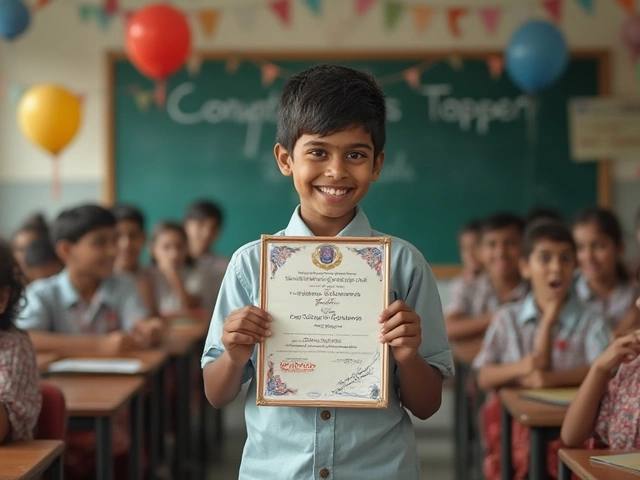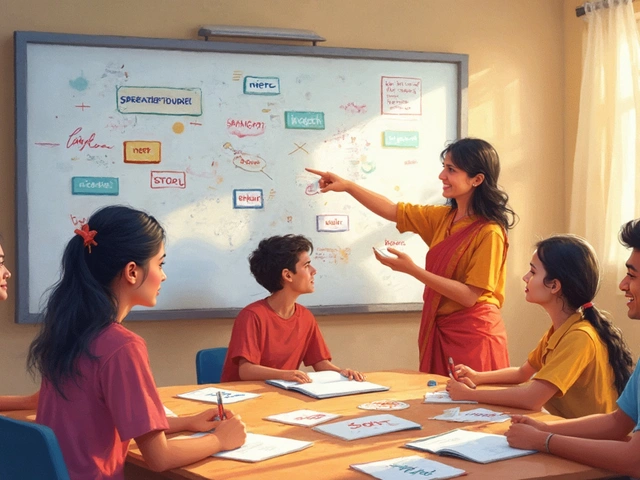
Thinking CBSE is just an Indian thing? You might be in for a surprise. CBSE isn’t stuck inside India’s borders. In fact, you can find CBSE schools sprinkled across the Middle East, Southeast Asia, and even Africa. You’ll spot them in places like Dubai, Abu Dhabi, Singapore, and Doha—local Indian communities usually fuel their demand.
For families moving overseas, staying on the CBSE track is a lifesaver. Kids don’t have to struggle with a whole new education system, and parents don’t have to stress about massive changes in textbooks or exam styles. It keeps things familiar, which helps especially if families return to India later.
- CBSE’s Global Presence
- Why Families Choose CBSE Abroad
- How International CBSE Schools Operate
- What to Expect as a Student or Parent
- Tips for Transitioning to a CBSE School Overseas
CBSE’s Global Presence
If you thought the CBSE syllabus is only for students in India, think again. The CBSE abroad scene is a lot bigger than most people expect. As of 2025, more than 240 schools outside India follow the CBSE curriculum. That's not just a handful—it's a big chunk spread over 28 countries.
Countries like the United Arab Emirates, Saudi Arabia, Oman, Bahrain, Qatar, Singapore, Malaysia, and even parts of Africa have established CBSE-affiliated schools. The United Arab Emirates leads the pack, hosting nearly 80 CBSE schools just in that region. Some Indian international schools in places like Singapore and Muscat are known for their strong academic results each year.
The Central Board of Secondary Education directly lists and oversees these overseas schools. They have to meet the same quality standards as Indian CBSE schools, and even the textbooks, syllabi, and exams pretty much mirror what’s used back home. This standardization is why so many expat and NRI families don’t think twice before choosing CBSE for their kids abroad.
“The CBSE curriculum offers stability for Indian families overseas, making transitions seamless for students who move between countries,” — Dr. Biswajit Saha, Director (Training & Skill Education), CBSE
Here’s a look at where CBSE is expanding:
| Country | Number of CBSE Schools |
|---|---|
| UAE | 80 |
| Saudi Arabia | 42 |
| Oman | 20 |
| Qatar | 15 |
| Bahrain | 10 |
| Singapore | 3 |
| Malaysia | 2 |
| Kenya | 1 |
International CBSE schools aren’t just copies of their Indian counterparts. They cater to the growing Indian expat population, but sometimes local students from other backgrounds also join in. The main thing to remember: if your child is already following the CBSE, there’s a good chance the same curriculum is available, even if your next move is halfway around the globe.
Why Families Choose CBSE Abroad
Ever wondered why so many Indian families pick CBSE when moving to places like the UAE or Singapore? The answer is simple: consistency and confidence. CBSE helps students fit right back into the Indian system later, but that’s not all. You’ll spot a ton of practical reasons too.
- CBSE abroad means familiar textbooks, grading rules, and exam styles. No need to stress about learning an entirely new curriculum when you’re already dealing with a move.
- Parents trust CBSE because it lines up with what Indian colleges expect. This makes applying for higher education back home way less confusing.
- Exams like NEET and JEE (popular Indian entrance tests) expect you to know the CBSE style. So, sticking with this syllabus keeps students prepped for those challenges.
Here’s a quick look at how many international CBSE schools exist in key countries, based on the official CBSE website as of May 2025:
| Country | Number of CBSE Schools |
|---|---|
| United Arab Emirates | 77 |
| Singapore | 4 |
| Oman | 21 |
| Saudi Arabia | 9 |
| Kuwait | 14 |
CBSE also offers all its materials in English, which helps a lot when students come from different regions in India or even different countries.
Many CBSE schools abroad hold on to Indian traditions—think festival celebrations and language options. This is a big deal for families who want their kids to stay connected with their roots while getting a solid education.

How International CBSE Schools Operate
International CBSE schools might look different from their Indian counterparts, but they stick closely to the core guidelines set by the Central Board of Secondary Education. To start a CBSE school outside India, management has to get special permission from the CBSE board and follow a bunch of rules. These include hiring qualified teachers, using approved textbooks, and sticking to the curriculum for every subject.
English is usually the main language of instruction, though you’ll often see Hindi and sometimes even other Indian languages offered as extra subjects. Examinations, grading, and syllabus updates are done just like in India because the CBSE board keeps a close eye. Exams for 10th and 12th grades—those crucial board exams—happen at the same time as in India, and results are published together worldwide.
Local regulations matter. CBSE schools in Dubai, for example, must meet extra requirements from the UAE government—everything from local staff ratios to health and safety. Still, these schools follow the official Indian calendar for exams and holidays, so transitions remain smooth for students moving between countries.
| Country | No. of CBSE Schools (2024) | Special Local Rules |
|---|---|---|
| UAE | 76 | Arabic language mandatory, compliance with KHDA |
| Singapore | 3 | Local teacher certification, multicultural events |
| Oman | 21 | Ministry of Education approval, Arabic studies |
| Qatar | 7 | Arabic studies, local teacher hiring norms |
CBSE abroad isn’t cheap. Fees in international CBSE-affiliated schools are usually much higher than Indian counterparts—sometimes triple or more. On the upside, schools tend to offer better facilities like modern labs, bigger libraries, and more clubs, giving students a solid edge. Parent-teacher interactions and cultural fests are pretty active, too, so the vibe is more community-driven than you might expect.
- Admissions mostly open around the same months as India (January to March).
- Digital resources and online learning tools are a standard part of classrooms abroad, especially post-2020.
- Transfer certificates from one CBSE school to another—anywhere in the world—are usually accepted without hassle.
If you’re planning to send your kid to a CBSE school overseas, check for the school’s official CBSE affiliation number online. That’s your sign everything is legit, with the right standards and promised curriculum.
What to Expect as a Student or Parent
If you’re jumping into a CBSE abroad school, the basics stay the same as in India: the syllabus, exam format, and grading system are pretty much identical. The textbooks often come straight from NCERT, and students still do board exams for Class 10 and 12, just like back home. That means study habits, daily routine, and subject choices will feel familiar—even in a new country.
One thing that throws some people off is the calendar. In the UAE, for example, the school year usually starts in April and ends in March, keeping with the CBSE India schedule. But in other places like Singapore, the school year could match the local system and run August to June, so you’ll want to double check your new school’s term dates before planning holidays or trips.
Classrooms are a mix of Indian expats and sometimes a few local or international students. The teaching staff often includes teachers from India, making the learning environment comfortable if your kid is used to typical Indian schools. Language is mostly English, but you’ll notice that many international CBSE schools offer extra foreign language subjects or local cultural lessons. Some even weave in activities focused on global issues or host events to blend different cultures.
It’s not just about the books. International CBSE schools usually step up when it comes to facilities. You’ll find better sports gear, tech-enabled classrooms, and sometimes after-school programs you might not see in regular Indian schools. Here’s a quick look at common features:
- CBSE-approved curriculum (NCERT textbooks)
- Indian and international teachers
- Options for extra languages (Arabic, French, Mandarin, etc.)
- Modern campus with updated labs and libraries
- Active sports and after-school clubs
For parents, staying in the loop is easier too. Most schools abroad use handy parent portals and regular email updates. Face-to-face meetings are still the norm, but you’ll also see schools setting up virtual parent-teacher conferences for extra flexibility.
Here’s a sampling of what you might come across, based on real numbers from popular regions:
| Region | Average Annual Fee (USD) | Student Body Size | Languages Offered |
|---|---|---|---|
| UAE (Dubai/Abu Dhabi) | 5,000 - 9,000 | Over 1000 per school | English, Hindi, Arabic |
| Singapore | 7,000 - 12,000 | 300 - 600 | English, Hindi, Mandarin |
| Qatar | 4,500 - 8,000 | 800 - 1200 | English, Hindi, Arabic |
| Malaysia | 3,500 - 7,500 | 400 - 900 | English, Hindi, Bahasa |
If you’re worried about missing Indian festivals or school events, don’t be. CBSE schools abroad go all out for Diwali, Holi, Eid, and Independence Day. The vibe around these events feels almost like being at home.

Tips for Transitioning to a CBSE School Overseas
Stepping into a new country and a new school system is nerve-wracking, even if you stick with the familiar CBSE format. Still, with a little planning, things can get much smoother—for both students and parents. Here’s how you can adjust without too much stress.
- Get your paperwork in order. Overseas CBSE schools will always ask for transfer certificates, previous mark sheets, a valid passport copy, and sometimes even a local medical certificate. Keep physical and scanned copies handy. This speeds up admissions and cuts down on headaches.
- Find out if the school follows the same calendar as in India. Some countries (like those in the Gulf region) start the academic year in September instead of April. You might need to bridge a gap or take an entrance assessment.
- Check language requirements. While the core CBSE subjects remain the same, some schools add compulsory foreign languages—like Arabic in UAE or Malay in Malaysia. You’ll want to catch up early so you’re not lost in classes.
- Ask about extracurriculars. Indian CBSE schools abroad often mix in local activities—think swimming in Dubai or robotics in Singapore. Get kids involved early to help them settle faster and make friends.
- Connect with other Indian families. Local WhatsApp groups or Facebook communities can clue you in on school bus routes, favorite tuition teachers, and even tips for local grocery shopping.
Here’s a quick comparison of CBSE school features in three popular overseas hotspots:
| Country | Medium of Instruction | Uniform Policy | Local Subjects |
|---|---|---|---|
| UAE | English | Strict formal uniform | Arabic mandatory |
| Singapore | English | Relaxed, weather-appropriate | None required |
| Qatar | English | Formal with school badge | Islamic Studies for Muslims |
If you’re worried about entrance tests or have questions for the school, don’t be shy about reaching out. Most international CBSE schools have counselors who deal with transitioning families all the time. Ask for a virtual school tour or a chat with current students before you join. It puts everyone at ease and sets things up for a smooth start in your new home.
Bottom line, if you stick to the essentials and tap into local support, you'll find the experience of switching to a CBSE abroad school is totally doable—even exciting.





